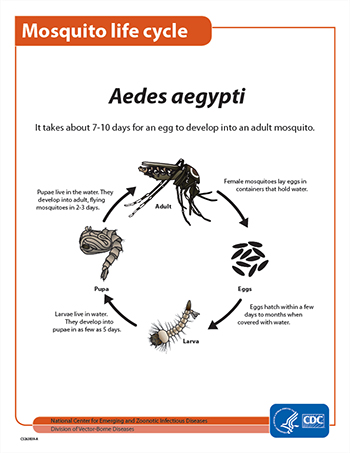Mosquito Biology
There are approximately 3,500 known mosquito species in the world, and 175 of those exist in the United States. There are about 55 species found in Virginia. Mosquitoes are closely related to flies but can be distinguished from them by their long piercing proboscis and scales on their bodies and wings. It is only the female mosquito that takes blood meals and thus only female mosquitoes that can transmit diseases. Most species of mosquitoes are entirely benign, while some are capable of spreading deadly and debilitating diseases. Tragically, the mosquito species capable of transmitting diseases are responsible for the death of over 800,000 people yearly, and many of these are children in the developing world. Mosquitoes are some of the most adaptable insects on the planet and found everywhere in the world, except for Antarctica and Iceland. In fact, there is a very good chance mosquitoes are breeding on your property, and you can find them if you know where to look.
 Life Cycle:
Life Cycle:
All mosquitoes need water to reproduce. However, we can distinguish two types of mosquitoes: one lays its eggs in permanent water, and the other lays its eggs in temporary water or flood areas. Mosquito Musketeers are primarily focused on the second group of floodwater mosquitoes because certain species from this group, such as Aedes aegypti and Aedes albopictus, have the potential to spread dangerous diseases in the greater DC area because they are peridomestic – meaning they live near people.
Eggs:
Mosquito eggs are brown or black, depending on the species and look like pepper spots. Certain species lay their eggs in attached groups known as rafts, and others lay them individually. These eggs are laid on the top of still water where they float or above the water line in areas that are prone to flooding, such as human-made containers and tree holes.
If an egg is laid outside of water and is subject to flooding, the embryo may develop in the egg but lay dormant through the winter when the weather is beginning to cool in early and mid-fall. Eggs will begin to hatch the following spring when the temperature routinely reaches 50-degree highs for extended days, and the amount of daylight increases (April in the Washington DC area). Eggs will then continue to be laid and hatch through the spring, summer, and early fall.
Larvae:
Once the mosquito egg hatches, it enters an aquatic larval stage. All mosquito larvae require water in which to develop and die if removed from water (hence the importance of tipping and tossing containers). Larvae stay suspended at the top of the water and breath through air tubes. The larvae feed on decayed organic matter such as decomposing leaves and microorganisms near the water surface. Larvae go through four stages (known as instar stages) in which they shed their exoskeleton to grow larger. In the greater Washington DC area, they take about 7 to 14 days to go through these stages depending on the species, temperature, and food availability in the water. Some species provide shaded pools while others prefer sunny ones
Pupal Biology:
After larvae, mosquitoes enter the pupal stage where no feeding occurs. Like larva, pupae breathe at the water surface. They are very active and dive deep into the water and are thus known as “tumblers.” The pupal stage lasts between 2 to 4 days in the greater DC area. At the end of this time, the pupae’s skin splits, and in two to three minutes, the adult mosquito emerges!
Adult:
After adult mosquitoes emerge, they will aggregate around hosts such as people waiting for females. This behavior is known as lekking and is why you will sometimes find swarms of mosquitoes around you. Mosquitoes mate right after emergence due to their high mortality rates. Female mosquitoes produce large amounts of eggs and feed on blood to get enough protein to develop eggs. Whereas females live three to four weeks, males live a week and feed on nectar. Female mosquitoes find their prey through their ability to sense carbon dioxide, body temperatures, and smells such as lactic acid. Most mosquito species oviposit (lay eggs) several times in their lives with each oviposit consisting of 150 to 300 eggs. Most mosquito species will feed at dawn and dusk, although some prefer to feed during the day or at night.
Treatment:
Knowing the mosquito life cycle is extremely important in devising the appropriate treatment. For example, in the greater DC area, from early spring to late June, it is extremely important to focus on eradicating mosquito eggs and larvae. This period is known as the Achilles Heel: mosquito control is very effective because it kills great numbers of eggs and larvae. Mosquitoes can only bite people and transmit diseases in their adult phase. So during the spring and early summer, our primary focus at Mosquito Musketeers is destroying eggs, larvae, and eliminating breeding sites. To accomplish our goal, we use an all-natural larvacide in addition to our organic sprays. Mosquito populations grow exponentially; a single egg that develops into an adult female can lay up to 300 eggs. Therefore, larval treatments early in the mosquito season reduce the population considerably.
Midsummer to early fall, Mosquito Musketeers still focuses on the eggs and larvae, but more attention is focused on killing the adult breeding mosquitoes that are causing the population to grow exponentially. By mid-fall, we must focus on killing adults and on tracking down and destroying eggs so that they are not able to overwinter and cause the cycle to begin the following spring again.
